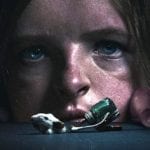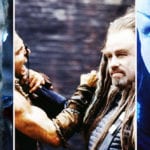 Animals
Animals  Animals
Animals  Weird Stuff
Weird Stuff 10 Weird Things People Used to Do at New Year’s
 Our World
Our World 10 Archaeological Discoveries of 2025 That Refined History
 Weird Stuff
Weird Stuff 10 Fascinating Facts You Might Not Know About Snow
 Miscellaneous
Miscellaneous Top 10 Things Crypto Was Supposed to Change & What Actually Did
 History
History 10 Huge Historical Events That Happened on Christmas Eve
 Music
Music 10 Surprising Origin Stories of Your Favorite Holiday Songs
 History
History 10 Less Than Jolly Events That Occurred on December 25
 Weird Stuff
Weird Stuff 10 Funny Ways That Researchers Overthink Christmas
 Politics
Politics 10 Political Scandals That Sent Crowds Into the Streets
 Animals
Animals 10 Species That Refused to Go Extinct
 Weird Stuff
Weird Stuff 10 Weird Things People Used to Do at New Year’s
 Our World
Our World 10 Archaeological Discoveries of 2025 That Refined History
Who's Behind Listverse?

Jamie Frater
Head Editor
Jamie founded Listverse due to an insatiable desire to share fascinating, obscure, and bizarre facts. He has been a guest speaker on numerous national radio and television stations and is a five time published author.
More About Us Weird Stuff
Weird Stuff 10 Fascinating Facts You Might Not Know About Snow
 Miscellaneous
Miscellaneous Top 10 Things Crypto Was Supposed to Change & What Actually Did
 History
History 10 Huge Historical Events That Happened on Christmas Eve
 Music
Music 10 Surprising Origin Stories of Your Favorite Holiday Songs
 History
History 10 Less Than Jolly Events That Occurred on December 25
 Weird Stuff
Weird Stuff 10 Funny Ways That Researchers Overthink Christmas
 Politics
Politics 10 Political Scandals That Sent Crowds Into the Streets
Top 10 Greatest Reverse Horror Movies Ever Made
In almost every horror movie ever made, a hero or heroine goes up against a ruthless killing machine. In the end, the monster is dead (until the next sequel), and life returns to normal, but that’s not the only format a horror movie can take.
There is a sub-genre known as Reverse Horror, which works like this: the monster is the protagonist, and the victims are the bad guys. That’s a bit of an oversimplification, but it will make sense when you check out these ten Reverse Horror films that are arguably the best the genre has to offer.
Incidentally, spoilers to follow…
10 Freaky Facts About Popular Horror Movies
10 Tucker & Dale Vs. Evil
While the film is definitely a comedy first, it’s also a brilliant take on the concept of a Reverse Horror movie, making it the best example ever put to film. This 2010 film starring Tyler Labine and Alan Tudyk is told from two points of view; the two guys in the title, and a bunch of teenagers who immediately assume they are evil backwoods monsters. In a normal horror movie, the plot would be simple: privileged kids make their way into hillbilly territory, make bad choices, and wind up being slaughtered, but that’s not how this movie plays out.
Instead, Tucker and Dale are ordinary guys who enjoy spending time in the woods. Sure, they’re rednecks, but they aren’t evil monsters. Despite this, a series of misunderstandings make it clear to the kids that they are the movie monsters they think they are, so they decide to do something about it. Of course, every action they take leads to their death in brutal and violent ways, which only serves to freak out the titular heroes of this film. The movie is ingenious at how it tackles the Reverse Horror genre, and it’s equally hilarious.[1]
9 Frankenstein
The story of Frankenstein’s Monster is one of pure tragedy, and that’s not just because people incorrectly identify the unnamed monster as “Frankenstein” all the time. The story is all about a scientist who wants to conquer the barrier between life and death. To do this, he commits various taboo acts by digging up the bodies of the recently deceased. He then stitches them together, and in an effort at playing God, Dr. Victor Frankenstein manages to give life to a superhuman specimen, and Frankenstein’s Monster was given life.
When the so-called monster makes his way into the world, he’s immediately treated as a villain. Each interaction with the people he meets plays out terribly for him. The thing about the monster is that he never asked to be made into the thing he became. Despite looking like a giant monster walking corpse, he was misunderstood and afraid of the outside world. He was treated as a monster, but in the end, it was the villagers who assaulted him and his creator, who treated him terribly that were the true monsters of the film.[2]
8 I Am Legend
Throughout most of I Am Legend, it’s clear who the monsters are, seeing as they look and act exactly like what a movie monster should be. They are nocturnal, enjoy eating the flesh of the living, attack anything they see, are allergic to sunlight, and have a nasty disposition. The movie follows Will Smith’s Colonel Robert Neville as he works tirelessly to come up with a cure to the infection that has turned the majority of the world’s survivors into merciless killing machines. He does this by taking them captive and injecting them with experimental vaccines based on his own immunity.
That last bit should have been a clue, and it becomes clear as the film makes its way into the third act. Neville has been kidnapping these so-called monsters for years, experimented on them, and ultimately, he ended up killing them in the process. Instead of the infected being the monsters, Neville was the monster all along, and the real victims were the infected, who have adapted to their condition to become the next step in human evolution. Neville represented the terror that struck during the day when they were vulnerable, and he realizes this too late as the film comes to an end.[3]
7 I Know What You Did Last Summer
When I know What You Did Last Summer hit theaters in 1997, it offered a somewhat new take on the slasher horror genre. In the movie, a group of kids are drinking and driving when they kit someone on a dark road. When they freak out over the implication of what a DUI/vehicular manslaughter charge will do to their futures, they agree to dump the body into the water, and never again discuss what happened. They went on to live their lives, but a year later, a letter shows up to one of the girls’ houses, stating, “I know what you did last summer!”
From that point forward, each of the people involved in the hit and run ends up on the wrong side of a massive hook, as they are slaughtered one by one. It’s a typical slasher horror movie, but with a twist. The killer is the man they hit and left for dead a year earlier. While his method of getting revenge is a little on the psychotic side, it’s hard to argue his victims didn’t deserve what they got. After all, they nearly killed him, dumped him in the water, and went about their lives, leaving him to pick up the pieces of his before finally going after the monsters (teenagers) who nearly killed him.[4]
6 King Kong
Whether it’s the original King Kong from 1933 or Peter Jackson’s remake in 2005, the film’s basis remains the same. A group of filmmakers heads out to a mysterious place called Skull Island, where a rumored beast is said to roam the dangerous landscape. Along with the filmmakers are the actors, one of whom is a beautiful woman starring as the film’s female lead. After arriving, everything goes to hell rather quickly, and the woman is sacrificed to Kong, the island’s gigantic ape, but he doesn’t eat her — he fancies her.
When she’s taken, the filmmakers head out to try and get her back, and in doing so, they manage to capture King Kong. With such a prize on hand, they have little choice but to head to New York City to show him off. They chain the King and premiere the beast to the world, but he manages to escape. After taking the woman up the Empire State Building, aircraft manage to shoot him down, killing the great beast. The movie closes with “It was beauty killed the beast,” but that’s not true. The real villains of this movie were the men who went into Kong’s home, stole him from it, and led to his death, making the giant beast the real victim of this film.[5]
10 Historic Events That Are Creepier Than A Horror Movie
5 Swamp Thing
At first glance, the muck monster that is the Swamp Thing is a classic movie monster, but he didn’t always look that way. Before he called the swamps his home, he was a man named Alec Holland, but when he’s doused in chemicals, set on fire, and dumped into the Louisiana swamps by Dr. Anton Arcane, his body mutated. He changed from being a normal human, and morphed into a new kind of creature… a monster of the swamps best described as a Swamp Thing!
His appearance is indeed that of a classic movie monster, as he’s made up of the muck and plant matter of the swamp. He also has superpowers, including increased strength, durability, and the ability to make plants grow and do his bidding, but he’s not the monster of this film. He’s actually the hero, and when his transformation is complete, he takes his vengeance out on Dr. Arcade and his henchmen. To anyone who knew the character before seeing the movie, they would have known who the true hero and villain were in the film, but a casual viewer… not so much.[6]
4 The Cabin In The Woods
On the surface, Cabin in the Woods seems like a typical horror movie featuring zombies, a group of unsuspecting teens, and a bunch of bad decisions, but it’s far more than that. The plot does follow a group of teenagers who vacation in a cabin in the woods, where they fall victim to zombies, but the undead aren’t the real monsters in this movie. There’s something going on under the surface — literally, under the cabin’s surface, which is where the real villains of this film could be found.
A couple of engineers named Sitterson and Hadley are the real bad guys in this movie. They are the ones manipulating the events in and around the cabin to ensure the kids meet proper horror movie deaths. It turns out, they are part of an international project meant to keep humanity from being destroyed by horrific subterranean deities called the Ancient Ones. They do this by manipulating the kids via pheromones and drugs that get them to engage in sexual activity and other horror movie tropes used to bring on the monsters. In the end, the kids turn out to be the victims of the engineers and their Director, while the zombies turn out to be little more than a tool used by them.[7]
3 The Others
Nikole Kidman took the role of Grace in 2001’s The Others, and the movie is incredibly strange but in a good way. In the beginning, she is shown to be incredibly overprotective of her children, who are allergic to sunlight (they aren’t vampires, it’s a real condition). She hires three people to help on her property, but soon after she does this, strange things begin happening all around the home. The curtains are drawn throughout the house, putting the children in jeopardy, and one of the children begins communing with the ghost of a little boy. Other paranormal events take place, and it’s clear the home is haunted.
As the film continues, more and more strange things occur, and it’s revealed that Grace did something terrible to the children in the past, but it’s not clear what that was. Just when the viewer thinks they know what’s going on, the whole plot is flipped upside-down, and it turns out that Grace and the kids (as well as the help) had been dead all along. The “ghosts” of the house were the living, who had taken up residence in the home long after Grace killed her children and herself. They were the ghosts, who had been terrifying the living all along.[8]
2 Poltergeist
Poltergeist spends a lot of time making sure the viewer knows that the ghosts haunting the house are not only causing trouble, but they are also malevolent and out to get the family. As each interaction with the poltergeists continues, the stakes are pushed higher and higher until Carol Anne is sucked into the television, leaving a hopeless family with few options in getting their daughter back. Add to that the murderous clown that still gives people nightmares, the corpses in the pool, and the deadly tree, and the villains in Poltergeist are clearly the ghosts.
Only they aren’t! As you make your way through the movie, it becomes clear that the ghosts aren’t evil spirits intent on destroying all life — well, most of them aren’t. Instead, they are the disturbed spirits of the people who were buried under the property. As the film closes out in the third act, Craig T. Nelson’s character grabs his boss and screams that they moved the tombstones, but they didn’t move the bodies! Ultimately, the living were the ones who caused all the problems and had the dead been treated with respect, none of the bad things that happened in the film would have come to pass.[9]
1 Carrie
Carrie is an interesting film due to the complexity of the characters and how it completely upends the nature of the titular girl in the end. As the movie begins, the viewer meets Carrie and her insane and fanatical mother, who barely manages to take care of her daughter. She’s mercilessly teased at school, and when she has her first period while in the school locker room, she freaks out because her mother never explained menstruation to her. This only makes the kids tease her more, and her life is clearly not going well.
By the third act, Carrie is taken to the prom, and she’s elated, but it doesn’t last long. When the kids pull a prank on her by dumping a bucket of pig’s blood all over her, it triggers her latent psychokinetic abilities. From there, the film shifts from Carrie being the victim to being the monster. She kills almost everyone attending the prom, up to and including the school teachers and administrators. With this, the film flips from straight-up horror to a reverse horror by redefining the main character from being the victim to also being the film’s villain.[10]
Top 10 Must-See Recent Genre-Defying Horrors








